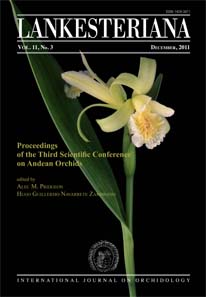Mating systems in the Pleurothallidinae (Orchidaceae): evolutionary and systematic implications
DOI:
https://doi.org/10.15517/lank.v11i3.18275Keywords:
Orchidaceae, Pleurothallidinae, reproductive system, pollination, self-incompatibilityAbstract
We developed a project addressing the determination of the reproductive system through experimental pollinations of species in the major genera representing all major lineages of Pleurothallidinae in order to determine occurrence of self-incompatibility in the subtribe, in which group it has possibly appeared for the first time, and how many times it has evolved. Additionally we surveyed the floral biology of species of Octomeria, a genus with morphological characters typical of bee-pollinated flowers that was previously regarded as mellitophilous. At the moment, all but one of the species studied in selected large genera of the major lineages (Acianthera, Anathallis, Masdevallia, Octomeria, Specklinia, and Stelis) are self-incompatible. The species studied may possess complete, strong or partial self-incompatibility. We found two different sites where self-incompatibility reactions occur, the stigma and the stylar channel, and both sites were not found in the same genus except for Anathallis. In Anathallis, the two groups that differ morphologically (formerly Pleurothallis subgen. Specklinia sect. Muscosae and sect. Acuminatae) exhibit different sites of reaction. Flowers of Octomeria species produce nectar and are pollinated by both male and female Sciaridae flies, and the populations have high genetic variability similar to that found in Acianthera species. Our results indicate that self-incompatibility is a generalized widespread feature of the myophilous clade of the Pleurothallidinae and possibly evolved early in the subtribe, enabling the maintenance of high levels of genetic variability in the populations of each species in spite of pollinator behavior. Moreover, although sapromyophily (pollination by female flies by deceit) is much more common in the group, myophily s.s. (pollination by anthophilous flies seeking nectar) apparently evolved first from the plesiomorphic mellitophilous condition. In addition to the morphological synapomorphy uniting the members of the former circumscription of the subtribe (an articulation between the ovary and pedicel), our results also point to the occurrence of two biological synapomorphies in the group — self-incompatibility and myophily. Based on these differences, we suggest the splitting of Pleurothallidinae as presently recognized into two subtribes: one composed of the large, self-incompatible, myophilous clade and the other of the small, self-compatible, ornithophilous clade.
Downloads
Downloads
Published
How to Cite
Issue
Section
License
According to the Open Access policy promoted by the University of Costa Rica, all the papers published by Lankesteriana are licensed under the Creative Commons copyright and can be downloaded free of charge. The journal holds copyright and publishing rights under the CC BY-NC-ND 3.0 CR license.
Before the publication of the materials submitted by the author(s) in LANKESTERIANA, the author(s) hereby assign all rights in the article to the Lankester Botanical Garden.





